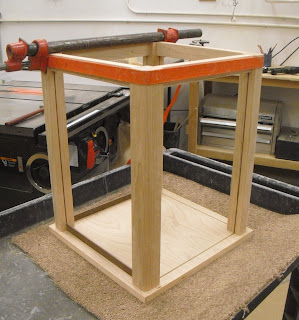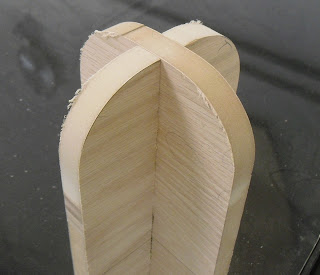A little over a year ago, one of the Thunderbird pilots came to my shop, requesting a case for his helmet. He needed it in a hurry - he was moving to Italy! Why do the Air Force guys always need their projects done yesterday? Here's a link to that old post, in case you missed it.

So a couple of weeks ago, a hottie in a uniform (pilot) wandered in the shop, needing another helmet case, only this one was for a general. Of course - again, no time to spare. Luckily, I had some Cherry in the shop, and quickly cut the parts. This case was going to be a little different - there needed to be a display area to hold some commemorative coins.
I cut the Cherry posts and rails, dadoing and tenoning them for assembly, as well as for holding the glass panels.
It actually went together pretty quickly, since I'd already built a case like this before. I made a few changes that really helped the design. Like what? Instead of bottom rails to hold the glass,
I just cut some stopped dados in the base. Much simpler and cleaner, although cutting stopped slots on a tablesaw is a cardiac workout. There is always the chance you might bring the blade up too high and cut through the base.
The helmet that was going in this case was being airbrushed, so I didn't have it in the shop. I only had a couple of minutes to measure it, and then off it when to the paint shop. Instead, I borrowed my buddy, Eddie's helmet to use for making the helmet stand.
Someone once suggested I buy a mannequin bust to rest the helmet upon, but I think that would look really cheesy. So - wood it is. (No pun intended)
Meanwhile, all Stella wanted to do was play.
To make the helmet bust, I started with a couple of scrap pieces of wood, and drew a line at their mid point. That dado is going to be cut halfway up one board, and halfway down the other, so that they intersect in the middle.
Here's how I cut it.
Is it time yet? (She's not smiling anymore.)
Once the dados are cut, I rounded the corners.
Honestly, I forgot to shoot photos when I built the small platform that holds the medallions. But you can see it here, mounted in the middle of the box.
Now she's pleading with me.
But I'm working on a deadline and don't have time to play!
Finally, time for the final wax and assembly.
I used glass retainer clips to hold the top piece of glass in place. But they interfered with the lid sitting flush on the case,
so I had to recess them.
Much better.
I'd forgotten that they fellow who ordered this requested that the lid be hinged, so that the helmet could be removed.
I couldn't find the right hinges anywhere here in town. But luckily - my friend Lupe bailed me out. She had a spare pair of Lee Valley hinges at her shop, and ran home to get them.
(I was in such a hurry to finish this piece that I forgot to shoot a picture with the lid open.)
Ok, now it's play time!

























































